The human body often reacts sharply to overload and stress, especially after 30 years. A feeling of heaviness, acute back pain in the lumbar region are all symptoms of stress or signals of the onset of serious pathologies, so they should not simply be ignored. Why does the back hurt and how to treat it?
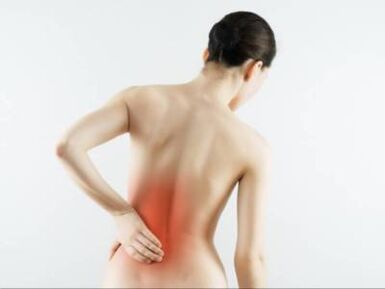
Symptoms
The difficulty of a correct diagnosis lies in the fact that many diseases can manifest themselves in this way, and it can also be a reaction of the organism to various external and internal irritating factors.
Finding out why the back hurts and making the correct diagnosis will help to correctly analyze the symptoms, which are very diverse.
Where is the size? This is an area of the back that captures the territory from the coccyx to the ribs, which contains many nerve endings and is divided into 2 halves by the spine.
To make a correct diagnosis, it is necessary to assess the localization of unpleasant sensations:
- Above the waist, on the right or on the left - such a symptom can be an indicator of inflammation of the internal organs: the liver (on the right) and the kidneys (on the right or on the left just above the waist). They can also be caused by hepatitis, liver failure, polycystic disease, cancer, pyelonephritis. If the kidneys are inflamed, the discomfort can radiate to the abdomen and hypochondrium.
- Below the waist - such symptoms characterize problems with the spine (lumbago, hernia, curvature), menstrual cramps and diseases of the genitals in women, intestines, inflammation of the appendix and genitourinary system inthe man.
Important! Unpleasant sensations in the back can arise from inflammation of the body and serious problems.
It is also important to assess the nature of the painful sensations:
- Shooting is a symptom of a pinched sciatic nerve. With inflammation of this nerve process in the back, a burning, shooting or tingling sensation appears, and their duration and strength may vary. They are especially aggravated by a change in body position, so most often a person can only stay in one position.
- Sharp pain in the lower back, most often stabbing. Also, a person experiences pulling sensations in the back area and cannot move normally, choosing a comfortable position. Such sensations can be symptoms of: diseases of the lungs and genitourinary system, displacement of intervertebral discs, renal colic, muscle fatigue.
- Chronic - constant discomfort in the back area, which disappears for a short time after taking painkillers, but then returns. They indicate spondylosis, osteomyelitis, tumors and metabolic disorders.
- Aching pain in the lower back - comes on suddenly, but lasts a long time. Weak painful sensations are symptoms of myositis, overstrain or hypothermia of the muscles;
- Displaced - occur with diseases of the colon, pelvic organs, pancreas or tumors.
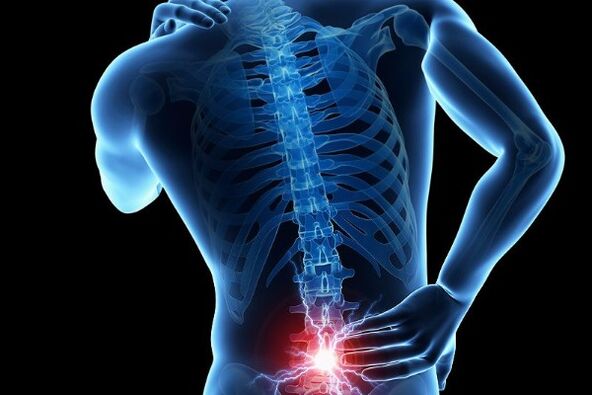
Important! Heaviness in the lower back is also a symptom of the inflammatory process in internal organs or muscles.
It is urgent to consult a doctor if the back pain is localized in one area, is chronic, and at the same time numbness and weakness of the limbs occur.
The reasons
There are several groups of different causes that can cause back pain. They are divided into natural and pathological or acquired.
Naturals include:
- intense physical exertion - due to the accumulation of lactic acid, muscle tissue loses its elasticity and begins to swell;
- sedentary work - due to lack of movement and, as a result, circulatory disorders, heaviness appears in the lower back;
- disturbances in the digestive system, which can radiate to the back;
- a long stay in the cold - a low temperature causes the vessels to narrow and slow blood flow, which causes discomfort;
- stress - with this phenomenon, the muscles of the spine go into spasm, causing a feeling of compression and discomfort.
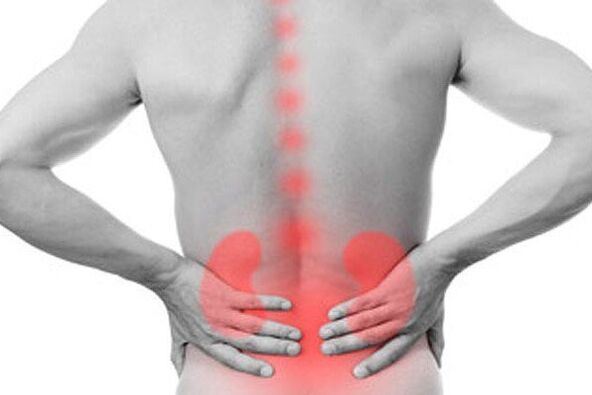
Pathological causes include:
- diseases of the spine - negative processes lead to serious illnesses, which are accompanied by constant discomfort;
- vascular diseases and heart diseases - if the cramps are concentrated in the region of the shoulder blades and under them, and are also accompanied by a feeling of compression, pressure drops and shortness of breath, then these are symptomsatherosclerosis and ischemia;
- inflammation of the sciatic nerve - if there is a sharp pain in the lower back and a person can only be in one position, then most likely this nerve has a cold;
- inflammation of the genitourinary system - nephritis, colpitis, endometritis and other diseases cause swelling of organs and their tissues in the waist area;
- muscle inflammation;
- trauma;
- diseases of the bronchopulmonary system.
Important! Due to the different structure and properties of the body in women and men, back pain can be symptoms of completely different processes.
Lower back pain in men can be linked to:
- kidney pathologies;
- reproductive system problems;
- consequences of trauma.

Lower back pain in men over 35 is very common because at this age they are at risk. Therefore, at the slightest symptom, you should contact the clinic. The risk group also includes men who:
- engaging in physical labor;
- leading a sedentary lifestyle;
- are overweight and have bad habits;
- have low immunity.
Which doctor to contact in case of problem? First of all, to the therapist, and he, after receiving the initial data and analyzes, will send the patient to an infectious disease specialist, gastroenterologist, cardiologist, urologist, nephrologist, neuropathologist orproctologist.
Women also often have lower back pain, but the reasons can be completely different from those of men.
There is no single answer, it could be:
- Premenstrual syndrome or cramps during menstruation - due to delays, hormonal failure, uterine contractions, tension and swelling of the tissues of the genitourinary system, there is tension in the pelvis and back pain in thelumbar region.
- Pregnancy - due to the increase in body weight, the pressure on the spine of the woman increases, which leads to tension in the lower back in the woman. It should be mentioned that in the early stages, heaviness and pain in the lower back can be a signal of the threat of miscarriage. Therefore, when they appear, immediately consult a doctor.
- After childbirth - if before childbirth the girl had problems with the spine, then after childbirth they do not disappear, but have a feature, on the contrary, to intensify due to the possible displacement of the vertebral discs orof their pinch.
- Gynecological diseases - pain in the lower back in women, which accompanies all inflammatory processes in the organs of the genitourinary system, occurs regardless of the load. Because of them there is heaviness and aching pain in the lower back. If there is sharp pain in the lower back, it is a symptom of ovarian rupture or ectopic pregnancy.
- Problems with internal organs and the spine.
The female risk group includes women who:
- have infections of the genitourinary system;
- the intestines are unstable;
- there are tumor diseases;
- sedentary work;
- complications after a cold;
- physiological changes;
- excessive physical activity;
- increased body weight;
- experience of epidural anesthesia in the past.
In addition to diseases and inflammatory processes in the body, there are a number of factors provoking pain in the lower back:
- hypothermia;
- sedentary lifestyle and rare physical activity;
- excessive physical activity;
- professional athletes, bodybuilders, bodybuilders, weightlifters should be especially careful.
If you belong to one of the risk groups, you should regularly exercise under the supervision of a qualified trainer, as well as be observed by a doctor, carrying out preventive actions aimed at preventing the occurrence of problemsback.
Treatment
If back problems have already occurred, preventive actions will not help. You should consult a doctor, find out the exact cause and start treatment. You can use the methods of traditional medicine or turn to the folk method, but any action should be agreed with your doctor. Which doctor should I contact? To begin with, to the therapist, and after finding out the reasons - to a narrow specialist.
Folk remedies
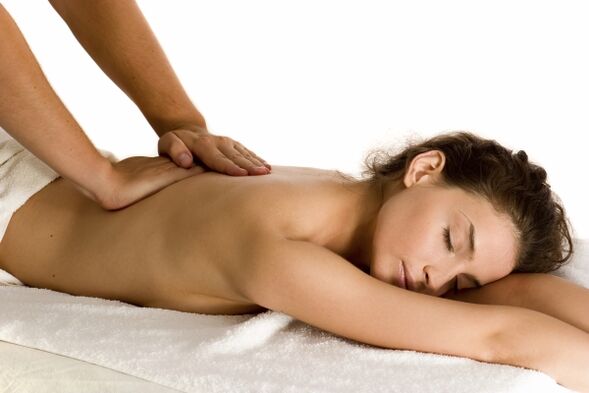
Traditional medicine involves the use of several methods of struggle:
- Massage - massaging a stiff back will help relieve tension and swelling. You can do self-massage, or you can contact a specialist, but only a proven one, so that he does not aggravate the problems that have already arisen.
- Physical exercises - regular exercises and warm-ups during the day are performed to relax the muscles and relieve muscle tension.
- Compresses - to relieve tissue swelling, compresses should be made from cabbage, burdock leaves and plantain. After putting them on and wrapping your back with a warm scarf, you need to lie down to rest for half an hour.
Traditional medicine can also be used as a prophylaxis to prevent serious problems. But if back pain in the lumbar region increases, and massage, compresses and exercises do not bring relief, you should immediately consult a therapist.
Contact a doctor
If the discomfort and aching pains in the lower back do not go away, and traditional medicine and massage do not help, how to treat? First of all, you should consult a therapist and find out their cause. For diagnosis, the back is examined in several ways:
- X-rays are taken to check for injuries.
- Ultrasound examinations are performed to exclude diseases and inflammations of internal organs. For this purpose, an MRI with CT can also be performed.
- General and biochemical analyses.
- An ECG and gastroscopy are done to exclude heart disease and disorders of the gastrointestinal tract.
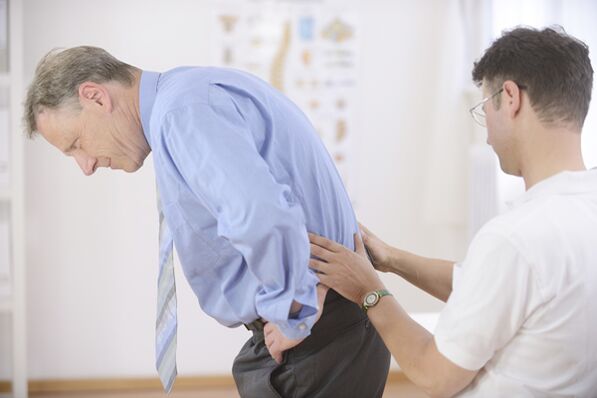
After an accurate diagnosis has been established, the patient is prescribed appropriate treatment measures:
- spine, joint, and muscle problems are treated with nonsteroidal medications, therapeutic exercise classes, and massage;
- cardiovascular diseases are treated by limiting physical activity and prescribing appropriate medication;
- diseases of the digestive tract imply compliance with a strict diet and drug treatments enveloping the intestines;
- bronchopulmonary pathologies are treated with antibacterial and antiviral drugs;
- problems of the pelvic organs - antimicrobial agents and physiotherapy.
In addition, you also need to take care of prevention:
- do not carry weight;
- always keep your back straight;
- sleeping on a hard mattress;
- avoid hypothermia, stress and overeating;
- treat acute illnesses in a timely manner.
Back pain is easily prevented by timely prevention: proper lifestyle, regular moderate exercise - all this will help prevent back problems and alleviate existing ones.


















